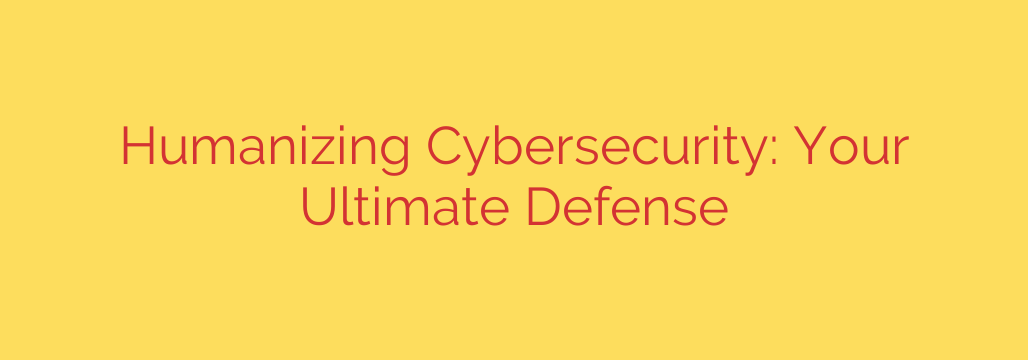
Beyond the Firewall: Why Your People Are Your Greatest Security Asset
In the world of cybersecurity, we often focus on complex technological defenses—firewalls, antivirus software, and encryption protocols. While these tools are essential, they represent only one part of a complete defense strategy. The most sophisticated and often overlooked element of any security system isn’t code or hardware; it’s the human element.
For too long, the narrative has painted people as the “weakest link” in the security chain. This mindset is not only outdated but actively harmful. True cyber resilience comes from shifting our perspective: instead of viewing people as a liability, we must recognize and empower them as our most dynamic and intelligent line of defense.
The Limits of a Tech-Only Approach
Cybercriminals are masters of manipulation. They know that the easiest way into a secure network is often not through a complex software vulnerability, but through a person. This is the foundation of social engineering, phishing scams, and pretexting attacks, which are designed to bypass technology entirely by exploiting human trust, urgency, and curiosity.
No amount of technology can fully protect against a cleverly crafted email that convinces an employee to click a malicious link or divulge sensitive credentials. This is where a human-centric approach becomes critical. A well-informed and vigilant person can spot contextual red flags that an automated system might miss, such as an unusual request from a “colleague” or a subtle inconsistency in an email’s tone.
Building Your Human Firewall: A New Security Culture
Shifting from a model of blame to one of empowerment is the first step in building a robust “human firewall.” This involves fostering a security-conscious culture where every individual understands their role in protecting the organization’s assets.
The goal isn’t to turn everyone into a cybersecurity expert, but to cultivate a healthy sense of skepticism and awareness. Effective security culture is built on continuous education and positive reinforcement, not fear-based training and punishment. When employees feel safe reporting a potential mistake or a suspicious email without fear of reprisal, the entire organization becomes stronger. A reported mistake is an opportunity to strengthen defenses, while an unreported one can lead to disaster.
Actionable Steps to Empower Your Team
Creating a human-centric security program requires a proactive and supportive strategy. Here are the key pillars for building a powerful human firewall:
Provide Ongoing, Engaging Education: Annual training sessions are not enough. Security awareness should be a continuous conversation, incorporating real-world examples, simulated phishing tests, and regular micro-learnings. This keeps security top-of-mind and helps employees recognize the latest threats.
Make Security Simple and Accessible: If security protocols are overly complex, people will find ways to work around them. Implement user-friendly tools like password managers and multi-factor authentication (MFA) apps, and create a simple, clear process for reporting suspicious activity. A “report phishing” button in an email client is far more effective than a multi-step manual process.
Foster a No-Blame Environment: The single most important factor in a security culture is psychological safety. Encourage employees to report anything that seems even slightly unusual, and treat every report as a valuable piece of intelligence. When someone clicks a bad link and reports it immediately, they should be thanked for their honesty, not reprimanded. This quick response can be the difference between a minor incident and a catastrophic breach.
Practical Security Habits for Everyone
While the organization plays a huge role, individual vigilance is paramount. Here are essential security habits that every person can adopt today:
- Scrutinize All Unsolicited Communication: Be wary of emails, texts, or calls that create a sense of urgency, ask for personal information, or contain unexpected attachments.
- Verify Before You Trust: If you receive a strange request from a known contact, verify it through a separate communication channel. Call them or send a new message to confirm the request is legitimate.
- Practice Strong Password Hygiene: Use a unique, complex password for every account. A trusted password manager can make this effortless. Crucially, enable multi-factor authentication (MFA) wherever it is offered.
- Think Before You Click: Hover over links to see the actual destination URL before clicking. If you don’t recognize the destination or it looks suspicious, don’t click it.
Ultimately, technology provides the walls of our digital fortress, but it’s the people inside who operate the gates. By investing in their knowledge, empowering them with the right tools, and fostering a culture of shared responsibility, we can transform our greatest perceived weakness into our most formidable security asset.
Source: https://www.helpnetsecurity.com/2025/10/09/human-factor-in-cybersecurity-video/








